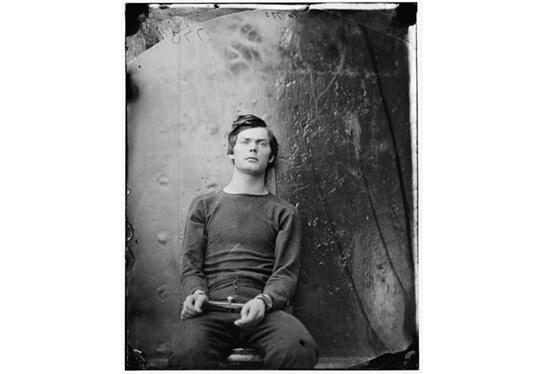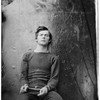Meditations on Photographs: Lewis Payne by Alexander Gardner

Now here’s a picture for our times: A photograph taken by Alexander Gardner in 1865, a portrait of Lewis Payne, one of the men involved in the assassination of Abraham Lincoln. If there ever was defiance, here we’d have it, and we love that kind of attitude, even (especially?) if it is on display by a soon-to-be-convicted (and hanged) criminal. It’s a handsome face, too, oddly out of time: You wouldn’t be surprised to meet someone looking, even dressing like this, in a local coffee shop. But Payne also looks like the hero in every movie - the dashing main figure who will escape into the night even if all his accomplices get caught or killed, the ruthless killer or violent lunatic that we still root for (think “Doug MacRay” in The Town). (more)
But there’s something else going on here. We also have a photograph that contains just the right mix of elements to make it look real, to make it feel almost contemporary. The photograph was taken with a large-format camera, which results in impressive detail and crispness in the center. At the edges, the emulsion is imperfect, which, together with the shallow depth of focus and the other artifacts (dust spots and scratches), results in maybe the most believable photograph you could take today: It can’t be too perfect, because we don’t trust perfect images any longer; it has to be imperfect, but in a way that stresses the maker’s impossible task (and not his skill in faking something imperfect).
Gardner took more than this one photograph that day. There are at least three other ones (see this list). One has the subject blurry (he moved his head during the exposure), another one clearly doesn’t have the right pose. The third comes close in its power to the one I’m discussing here - the look into the (imaginary) distance (on that ship there can’t have been much space) is made all the more believable by the slightly furled brows. It’s not quite the same quality as the defiant stare - but it’s pretty good.
Which has me wondering what might have gone on in the ship that day, the photographer setting up his large camera, fiddling with the plates, and then instructing his subject… Instructing? Guiding? Something must have happened, because the variety of the poses makes me guess that instructions were uttered, and those instructions were then followed, followed very well indeed. Here was a natural talent, someone almost made for the camera’s lens, someone who knew about his visual powers, a twenty one year old man used to seeing heads turning.
All of this combined gives us a very contemporary portrait, a portrait of a person long dead that presses our many cultural buttons neatly: The cult of the handsome hero, youthfully defiant, captured in an imperfect photograph, which is more believable because of its imperfections.
We look at photographs, and we believe we look across an ocean of time, but often we simply look at traces of the past reflected in our own times.
Photo: Alexander Gardner - Lewis Payne, 1865. You can find copies of the photograph on this Library of Congress page. There are more photographs of Payne on that site, to be found here.
 By
By 